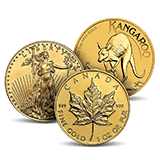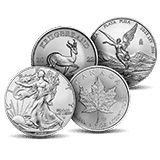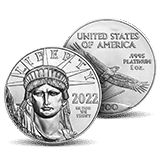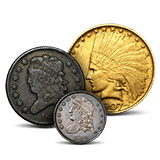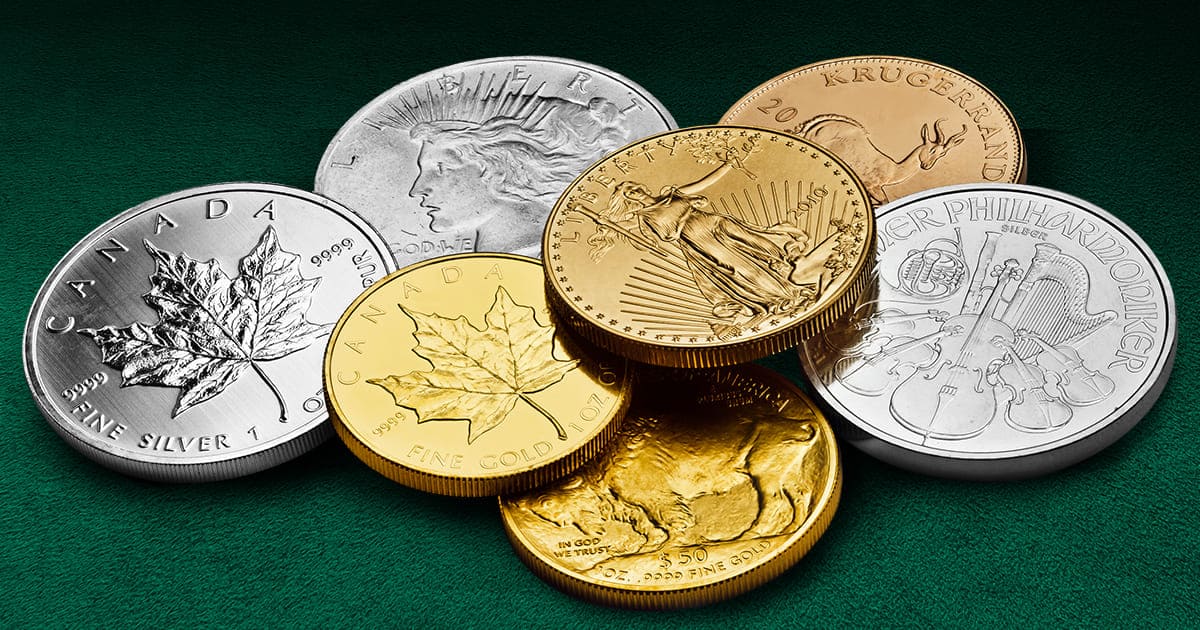
Bullion, in its simplest form, refers to precious metals such as gold, silver, platinum, or palladium in the form of bars, ingots, rounds, or coins. These metals are typically refined to a high degree of purity and are valued based on their precious metal content. Unlike collectible coins or numismatics, which derive their value from rarity and historical significance, bullion’s value is primarily determined by the current market price of the metal it contains.
Types of Bullion
Gold Bullion
Gold bullion is the most well-known and widely traded form of bullion. It comes in various forms, including bars, coins, and rounds. Gold bullion is often favored by investors as a hedge against inflation and currency devaluation due to its intrinsic value and historical stability.
Silver Bullion
Silver bullion, like gold, comes in the form of bars, coins, and rounds. While silver is often overshadowed by gold in terms of value, it plays a crucial role in industrial applications, making it a valuable commodity beyond its monetary worth.
Platinum Bullion
Platinum is a rare and valuable metal that is highly sought after for its various industrial uses, particularly in the automotive and jewelry industries. Platinum bullion is available in the form of bars and coins and is considered a valuable addition to a diversified investment portfolio.
Palladium Bullion
Palladium is another precious metal that has recently gained popularity among investors. Like platinum it is used extensively in the automotive industry, particularly in catalytic converters. Palladium bullion is available in bars and coins and allows investors to diversify their portfolios further.
The Value of Bullion
Several factors, including supply and demand dynamics, geopolitical events, economic conditions, and investor sentiment, primarily determine the value of bullion. Unlike stocks or bonds, which can be influenced by company performance or interest rates, the value of bullion is directly tied to the price of the underlying metal it contains.
How Does Ore Become Bullion?
Precious metal bullion is not the same as the mined raw ore. The transformation of precious metals into bullion involves careful processing to maintain quality, purity, and authenticity, ensuring they meet investors’ expectations.
- Mining: Precious metals like gold, silver, platinum, and palladium are typically extracted from the earth through mining operations.
- Refining: Once mined, the raw ore undergoes refining processes to remove impurities and enhance its purity. This refining can involve various techniques such as smelting, electrolysis, or chemical processes.
- Casting: After refining, the purified metal is cast into bars, ingots, or other standard shapes. This step ensures uniformity in size and weight, essential for bullion.
- Stamping: Bullion bars or ingots are often stamped with markings that indicate the metal type, purity, weight, and the mint or refinery that produced them. This provides authenticity and traceability.
- Packaging: Finally, the stamped bullion products are packaged securely for distribution and sale. This packaging typically includes protective materials to prevent damage during transit and storage.
Human’s History with Bullion and Precious Metals
Humans have held a profound fascination and appreciation for bullion, dating back to ancient civilizations. The allure of precious metals such as gold, silver, platinum, and palladium transcend geographical boundaries and cultural differences, making them universally cherished assets.
Ancient Civilizations
The use of bullion can be traced back to ancient civilizations such as Mesopotamia, Egypt, Greece, and Rome. These societies recognized the intrinsic value of precious metals and utilized them for various purposes, including trade, currency, and adornment. Gold, in particular, held a special significance in many ancient cultures, symbolizing wealth, power, and divine status.
Gold Standard
One of the most significant milestones in the history of bullion was the adoption of the gold standard, which emerged during the 19th century. Under the gold standard, currencies were directly linked to the value of gold, providing stability and confidence in monetary systems. This era witnessed a proliferation of gold bullion as governments and central banks amassed reserves to support their currencies.
California Gold Rush
The California Gold Rush of the mid-19th century sparked a frenzy of gold fever as prospectors from around the world flocked to California in search of fortune. The discovery of vast gold deposits fueled a massive influx of migrants and accelerated the global circulation of gold bullion. The California Gold Rush epitomized the human pursuit of bullion and its transformative impact on societies and economies.
Modern Bullion Markets
In the modern era, bullion markets have evolved into sophisticated trading platforms where investors can easily buy, sell, and trade precious metals. Bullion exchanges, such as the London Bullion Market Association (LBMA) and the Chicago Mercantile Exchange (CME), are pivotal in facilitating transactions and setting global benchmark prices for precious metals.
How is Bullion Utilized?
Bullion, consisting of precious metals like gold, silver, platinum, and palladium, serves various purposes beyond its intrinsic value.
Investment
Store of Value: Bullion serves as a reliable store of value, particularly during times of economic uncertainty or currency devaluation. Investors purchase bullion as a hedge against inflation and market volatility, preserving wealth over the long term.
Portfolio Diversification: Bullion offers diversification benefits to investment portfolios by exposing assets with low correlation to traditional financial markets, such as stocks and bonds. Diversifying with bullion helps mitigate risk and enhance overall portfolio stability.
Speculation: Some investors engage in speculative bullion trading to profit from short-term price fluctuations in precious metal markets. Speculative trading can involve buying and selling bullion derivatives, such as futures contracts and options, to capitalize on market movements.
Industrial Applications
Electronics: Silver, platinum, and palladium are essential components in the manufacturing of electronics, including smartphones, computers, and automotive electronics. These metals possess unique properties that make them indispensable for conducting electricity, catalyzing chemical reactions, and providing durability in electronic devices.
Catalytic Converters: Platinum and palladium play a critical role in catalytic converters, which vehicles use to reduce harmful emissions from exhaust gases. These metals facilitate chemical reactions that convert harmful pollutants, such as carbon monoxide, nitrogen oxides, and hydrocarbons, into less harmful substances like carbon dioxide, nitrogen, and water vapor.
Jewelry and Ornaments
Gold and silver have been prized for millennia for their beauty and malleability, making them ideal materials for crafting jewelry and ornamental objects. Bullion is used to create a wide range of jewelry pieces, from simple rings and necklaces to elaborate bracelets and earrings. Platinum and palladium, with their lustrous appearance and durability, are also valued for high-end jewelry designs.
Monetary Systems
Historically, bullion has served as the foundation of monetary systems, with gold and silver coins circulating as currency in many ancient and modern societies. While fiat currencies have largely replaced metallic currencies in everyday transactions, central banks and governments continue to hold significant reserves of bullion as part of their official reserves. Gold, in particular, remains a symbol of wealth and stability in the global financial system.
Collectibles and Numismatics
Collectors and numismatists often seek bullion coins and bars for their rarity, historical significance, and aesthetic appeal. Collectible coins, such as commemorative issues and limited-edition releases, can command premiums above their intrinsic metal value due to their numismatic value and cultural significance.
Bullion Banks
Bullion banks are financial institutions specializing in trading and dealing with precious metals, primarily gold and silver. These banks play a crucial role in the global bullion market by providing a range of services to clients, including miners, refiners, jewelers, investors, and central banks.
Bullion banks play a pivotal role in facilitating the smooth functioning of the global precious metals market, providing essential services to a diverse range of clients, and contributing to market liquidity, efficiency, and transparency.
Bullion banks frequently interact with central banks and official sector institutions as counterparties in gold transactions and reserve management activities. Central banks may engage bullion banks in gold lending and swap arrangements to optimize their gold reserves and generate returns on idle assets.
As an individual investor, you will likely never directly interact with bullion banks, but they may influence the market and the price of precious metals.
Investing in Bullion
Investing in bullion can be an excellent way to diversify your investment portfolio and protect your wealth against economic uncertainty. Here are some key considerations for investors looking to add bullion to their investment strategy:
Determine Your Objectives
Before investing in bullion, defining your investment objectives and risk tolerance is essential. Are you looking for a long-term store of value, or are you seeking short-term gains? Understanding your goals will help you make informed decisions about the types of bullion to invest in and the quantity to acquire.
Research the Market
Stay informed about the latest developments in the precious metals market, including price fluctuations, supply and demand dynamics, and geopolitical events that may impact prices. By staying abreast of market trends, you can make more strategic investment decisions and capitalize on opportunities.
Choose the Right Form of Bullion
When investing in bullion, you have several options, including bars, coins, and rounds. Each form of bullion has advantages and disadvantages, so it is essential to consider factors such as liquidity, storage costs, and premiums before deciding. You may also choose a more hands-off approach by investing in precious metals ETFs, futures, or certificates.
Consider Storage Options
Once you have acquired bullion, you must decide how to store it securely. While some investors prefer to store their bullion at home or in a bank safe deposit box, others opt for third-party storage facilities or allocated storage accounts. Evaluate the pros and cons of each storage option to determine the best solution for your needs.
Stay Disciplined
Like any investment, investing in bullion requires discipline and patience. Avoid making impulsive decisions based on short-term market fluctuations and stick to your long-term investment strategy. Maintaining a disciplined approach can position yourself for success and weather market volatility more effectively.
Bullion represents a tangible and time-tested asset class that can play a valuable role in a diversified investment portfolio. Whether you are a seasoned investor or just starting, understanding the fundamentals of bullion and how to invest wisely can help you achieve your financial goals and protect your wealth for the future.

